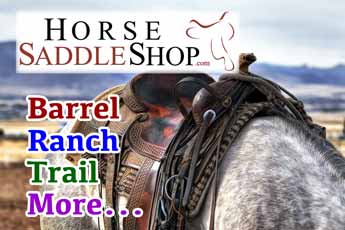What Is Flag and National Anthem Etiquette At A Rodeo?
In the United States, rodeos and rodeo-related events are usually opened with the formal presentation of the Flag of the United States of America.
The presentation of the American flag is followed by the playing of the National Anthem.
The information below describes the proper way for US citizens within US jurisdictions to show their respect for the American flag and National Anthem.
Below: The United States flag being formally presented horseback.
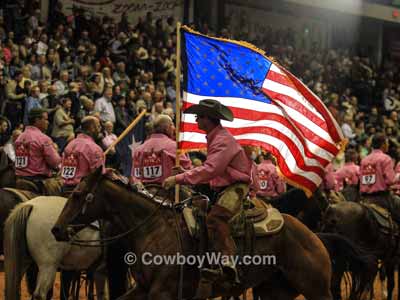
It should be noted that while flag and/or National Anthem etiquette is federal law as defined by the United States Code, there are no provisions for enforcement.
Flag / National Anthem Etiquette: The Short Version
Proper etiquette for the formal presentation of the Flag of the United States of America and the playing of the National Anthem is established by the United States Flag Code.
We have provided links to the exact wording in the Code further below on this page, but for now we have summarized it to create a "short version" of the etiquette it describes:
- All persons present in uniform should render the military salute.
- Members of the Armed Forces and veterans who are present, but not in uniform, may render the military salute.
- All other persons present should face the flag and stand at
attention with their right hand over the heart.
- If a person is wearing a headdress (such as hat), they should remove their hat with their right hand and hold it at their left shoulder. Holding their hat in this manner should place their right hand over their heart.
- Please note! Removing headdress has not traditionally been applied to women. Please see "Things To Consider #2 - Women and Hats," below.
- Citizens of other countries present should stand at attention.
- All such conduct toward the flag in a moving column should be rendered at the moment the flag passes.
Below: As the United States flag is formally presented at a ranch rodeo, notice: The spectators are standing, and most have placed their right hands over their hearts and have removed their hats.
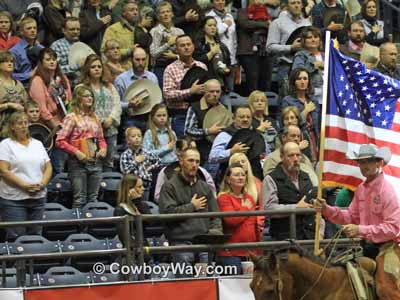
It's worth mentioning that the Flag and National Anthem etiquette described above applies the United States Flag only. Other flags, including state flags, are not subject to the same code of conduct.
Below: The New Mexico state flag being formally presented. State and other flags are not subject to the same conduct of respect as the US Flag.
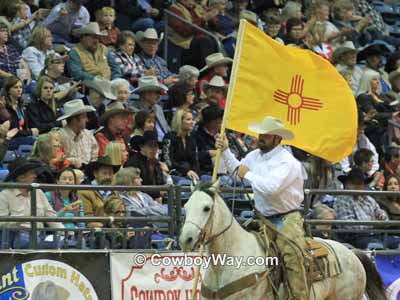
Things To Consider #1 - Casually Seeing The Flag
Keep in mind that there is no need to observe the above etiquette if you merely see the flag.
For example, at a rodeo the flag is often carried by a mounted rider. If the rider should carry the flag into the arena during a warm-up period prior to the rodeo there is no need to stand at attention and/or salute.
However, when the flag is formally introduced and passes by, rules of proper etiquette and respect apply.
Things To Consider #2 - Women and Hats
As we mentioned above, removing a hat during the formal presentation of the American flag and the playing of the National Anthem has not traditionally been applied to women.
This is possibly because at the time the Flag Code went into effect (1923) the vast majority of women's hats were difficult and time consuming to remove and put back on.
Current Customs
Today, though, with the popularity of casual, unisex hats among women that are easily removed and put back on (such as a cowboy hat or ball cap) some women voluntarily remove their hat for the presentation of the flag and/or the playing of the National Anthem.
To address this issue some, but not all, current hat etiquette guides recommend that a woman continue to wear a formal hat or a hat that is difficult to remove and put back on. However, they also recommend that a woman remove a casual, unisex-type hat.
Traditional Customs
However, many people have been instructed in the traditional understanding of the Flag Code whereby a woman is not expected to remove her hat during the presentation of the flag and/or the playing of the National Anthem.
Therefore, to the best our knowledge, a woman should not automatically be considered to be disrespectful if she leaves her hat on during these times. She may simply have been instructed in the traditional understanding of the Flag Code.
Below: The National Anthem being played at a women's ranch rodeo. In the background you can see most of the women have chosen to remove their hats, but at least two have not.
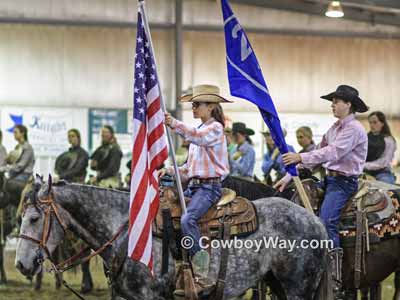
Things To Consider #3 - Not All Headdress Is The Same
It is worth mentioning that during the formal presentation of the flag and the National Anthem that not all "headdress" is the type that needs to be removed.
For example, religious headdress has traditionally been considered an exception and may be left on.
Things To Consider #4 - People Who Are Working
While there are not any formal guidelines that we are aware of, there are a few generally accpeted exceptions to placing hands over hearts and/or removing hats for people who are working.
For example, a United States flag is often presented in a darkened rodeo arena with a moving spotlight on the flag. The worker who is running the spotlight is not considered disrespectful if he or she cannot observe proper etiquette because they are busy operating the spotlight.
Other exceptions might include a photographer who is photographing the event, and stock contractors and others working with livestock who are not able to pause in their work.
Other exceptions may also apply.
Read The United States Flag Code
We gave the "short version" of proper United States flag and National Anthem Etiquette above. Military.com has an excellent page where you can read the pertinent parts for yourself: Conduct During The Passing Of Colors and Conduct During The National Anthem.
Rodeo Announcers and Etiquette
At most rodeos, the rodeo announcer will probably politely remind you of when to stand and pay respect to the flag, and to remain standing during the National Anthem.
The announcer will likely not be overly specific as to the other guidelines of respect as contained in the United States Flag Code (given above), so you should know these guidelines for yourself.
A rodeo announcer may also remind people to "remove cover," which is another way of reminding you to remove your hat.
Exceptions and Special Rules For Mounted Flag Carriers
In addition to exceptions for people who are working, there are some additional common sense exceptions to the Code for some other people.
For example, mounted flag carriers are generally considered exempt from removing their hats and/or placing their hands over their hearts because their hands are busy with riding their horses. Other exceptions may also apply.
Guidelines For Mounted Flag Carriers
As mentioned in the previous paragraph, some exceptions to the Flag Code apply to mounted flag carriers. However, they have other guidelines of respect for our country to follow.
For example, a mounted rider carrying the American flag (as opposed to a state flag or some other flag) should never follow another flag, but instead always lead any other flags that may be present.
In addition, a rider carrying the American flag should never dip the American flag, but other flags may be dipped in respect for the American flag.
The guidelines mentioned above are for example only, and are by not means complete! For additional information on guidelines for mounted flag carriers we suggest you see this page for mounted drill teams, as many of their guidelines apply to flag carriers in general: Western States Equestrian Drill Team Association flag protocol.
Below: At the Cheyenne Frontier Days Rodeo, a member of the Cheyenne Dandies Drill Team dips her sponsorship flag in respect as the United States flag enters the arena.
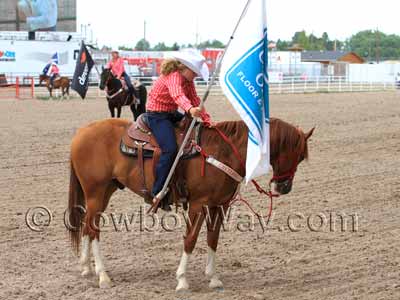
Safety While Posting The Colors
We have an important safety tip for posting the colors at a rodeo: What Is A Safety Tip For Posting The Colors At A Rodeo?
What Is / Are...
… What Are 5 Of The Biggest Wild West Robberies?
… What Are 5 Reasons Horse Trailer Lighting Matters?
… What Are 8 Dumb Things To Say To A Horse Lover?
… What Are 9 Proven Ways To Keep Flies Off Horses?
… What Are Chestnuts and Ergots?
… What Are The Parts Of A Western Saddle?
… What Are Saddle Rigging Positions?
… What Are Some Fencing Options?
… What Are Some Foods Both Horses And Dogs Can Eat?
… What Are Some Horse Fencing Basics?
… What Are Some Interesting Horse Facts?
… What Are Some Interesting Charts and Graphs With Horse Information?
… What Are Some Options For Temporary Horse Fencing?
… What Are Synthetic Saddles Made Of?
… What Are The Rodeo Catch Pens?
… What Are The 10 Best 3-Horse Trailers With Living Quarters In The USA And Canada?
… What Are The X's In A Cowboy Hat?
… What Are The Three Legal Head Catches?
… What Is The Angle System For Branding?
… What Is The Barrel Racing Pattern?
… What Is A Bull Riding Vest Made Of?
… What Is Deworming Your Horse?
… What Is A Domain Name?
Why would I need one for my farm or ranch even if I don't have or
want a website?
… What Is A Fifth Wheel Trailer Hitch?
… What Is Flag and National Anthem Etiquette At A Rodeo?
… What Is A Slant Load Horse Trailer?
… What Is Floating A Horse's Teeth?
… What Do Horse Freeze Brands Look Like?
… What Is A Galvayne's Groove?
… What Is A Gooseneck Trailer Hitch?
… What Is Some History About The First National Finals Rodeo?
… What Is The History Of The Modern, Hornless, Bronc Riding Saddle?
… What Is The History Of The Modern Rodeo Bucking Chute?
… What Is The History Of The One-Hand Bareback Rigging?
… What Is The Nasolacrimal Duct In Horses?
… What Is A Pony Express Mochila?
… What Is Hermann Oak Leather?
… What Is Larvicidal De-Worming?
… What Is The Flehmen Response?
… What Is The Rodeo Return Gate?
… What Is A Safety Tip For Posting The Colors?
… What Is A Slick Fork Saddle?
… What Is A Swell Fork Saddle?
You Might Also Like
